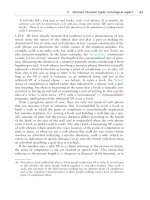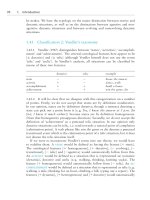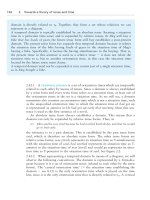The grammar of the english verb phrase part 120 pps
Bạn đang xem bản rút gọn của tài liệu. Xem và tải ngay bản đầy đủ của tài liệu tại đây (78.19 KB, 7 trang )
826 Glossary
speech act (i. e. assertion, question, instruction, etc.) that he makes by uttering
the head clause. For example: [You’d better hurry up,] because there’s going to
be a storm.
Value (of specificational sentence): that constituent of a specificational struc-
ture that is specified as value for a presupposed variable, e. g. a book in It was
a
book
that I gave him, What I gave him was a
book
, I gave him a
book
,A
book
was what I gave him. The value constituent always receives a heavy
(contrastive) accent.
Value constituent: constituent representing the value of a specificational sen-
tence, e. g. a book in What I gave him was a
book
.
Vantage time: a point in time or a time interval from which (the actualization
of) a situation is viewed as ongoing (ϭ in progress) by the speaker referring to
that progressive situation. The vantage time is explicitly mentioned in sentences
like At 7 p.m. I was still working.
Variable (of specificational sentence): the (presupposed) constituent of a specifi-
cational structure for which a value is specified (or, in questions, asked). For
example, in each of the following sentences the variable is ‘the x that I gave
him’: It was a
book
that I gave him, What I gave him was a
book
, I gave him
a
book
,A
book
was what I gave him.
Variable constituent: constituent representing the variable of a specificational
sentence, e. g. What I gave him in What I gave him was a
book
.
Verb complement: a VP-internal argument of a verb (i. e. any argument of the
verb that is not the subject), such as a direct object (e. g. I hit him), indirect
object (e. g. I gave him a kite), subject complement (e. g. Bill is ill), object
complement (e. g. We called him a fool), prepositional object (e. g. I looked
into the question carefully).
Verb form: particular form of a verb. In Bill sneezed, the verb form sneezed
consists of a conjugated form of the verb sneeze only; so does takes in Bill
takes drugs;inBill may have been working, the verb form consists of the
participle form of the main verb (working) preceded by three auxiliary verbs;
in John will leave now, the form consists of one auxiliary followed by the
present infinitive form of the main verb.
Verb of creation: verb like write, form or build, which expresses the making
(bringing into existence) of something. In clauses like A problem has {arisen /
cropped up}, the verbs arise and crop up are also called verbs of creation
because they refer to the coming into existence of something.
Verb phrase (VP): phrase whose head is a main verb. In the clause John left
the house last night, the verb phrase is left the house last night. In this case the
Glossary 827
verb phrase constitutes the entire predicate constituent. (The latter comprises
the verb phrase plus the optional adverbials, if any.) A verb phrase minimally
consists of a verb form. It also includes the verb complement(s) and/or the
necessary adverbial(s), if any.
Verb stem: that part of the verb that remains constant in the different forms
of the verb, e. g. unchain in unchains, unchained, unchaining. As a rule, the
stem is identical in form with the present infinitive or the present subjunctive
form of he verb.
Voice auxiliary: the grammatical auxiliary be when it is used to build a passive
verb form.
VP: conventional linguistic abbreviation of verb phrase.
W-anterior: time A is W-anterior to time B if it is anterior to B without neces-
sarily being represented as T-anterior to time B by a tense form.
W-anteriority: anteriority that exists in the actual world (or in whatever non-
factual world is being referred to) but which is not necessarily expressed by
the tense used. For example, in I left before John arrived, my leaving is W-
anterior to John’s arrival, but it is not represented as T-anterior to it by the
tense form left.
W-bounded: said of a bounded situation whose boundedness is not a question
of linguistic representation – see L-bounded – but merely a matter of interpreta-
tion based on pragmatic inference. For example, out of context the sentence
John was in the park this morning will be taken to imply that John is no longer
in the park at the temporal zero-point, but this implicature can be cancelled
by a contextual addition like and he told me he would stay there until you
came to fetch him, so you’d better hurry off. In other words, in isolation the
sentence John was in the park this morning is by implicature interpreted as W-
bounded, but is not L-bounded (ϭ linguistically represented as bounded).
W-bygone situation: situation which is conceived of as completely over at the
temporal zero-point, as in I’ve closed the door; Once upon a time there was a
princess who felt very lonely.
W-concept: concept which has to do with the interpretation of situations and
temporal relations in the actual world or in whatever alternative world is being
referred to. (contrasted with T-concept)
Weak verb: see regular verb.
Weak intensional verb: verb like see or say, which establishes an intensional
domain but allows its object clause to create a new temporal domain so that
the clause in question receives a transparent interpretation rather than an inten-
828 Glossary
sional (opaque) interpretation. There is such a shift of domain, e. g. in Bill
{saw / said} that the bridge is rather mouldered. See also strong intensional
verb.
Wh
-question: interrogative sentence or subclause containing a question word
(usually in initial position), with the question having narrow scope (over the
questioned constituent only), e. g. Who did that? – [I don’t know] who did that.
Wide scope negation: negation with scope over the entire clause or sentence,
as in These spiders are not dangerous (ϭ ‘It is not the case that these spiders
are dangerous’).
Wide scope question (or ‘polar question’or‘
yes
/
no
-question’): interrogative
sentence or subclause expressing a question which invites either yes or no as
an answer (e. g. Did you tell him about me?). That such questions have wide
scope is illustrated by the fact that they allow a paraphrase like Is it true that
…? or Is it the case that …?
W-interpretation: (a) in general: temporal reading which is not exclusively
based on the semantics of the chosen tense but also takes into account such
elements as temporal adverbials, context, situation of speaking, knowledge of
the (actual or nonfactual) world referred to and pragmatic principles such as
the Gricean Maxims of conversation; (b) in connection with the present perfect:
one of three possible readings related to the full situation: the ‘indefinite read-
ing’ (i. e. the full situation comes to an end before the temporal zero-point),
the ‘continuative reading’ (i. e. the time of the full situation includes t
0
) and
the ‘up-to-now reading’ (i. e. the terminal point of the full situation preceding
t
0
is adjacent to t
0
).
W-nonbounded: said of (the time of actualization of) a full situation which is
not interpreted as bounded, even though its situation time may be represented
as bounded. For example, in From 9 to 12 Tom was not in his office, the
situation time is bounded by virtue of being contained by (in this case: coincid-
ing with) the Adv-time specified by the heterogeneous time adverbial from 9
to 12. However, unless from 9 to 12 is taken to represent important new infor-
mation, the time of (actualization of) the full situation is not interpreted as
bounded: Tom may also have been absent from his office before nine and/or
after 12. In fact, it is theoretically possible that he has never been in his office.
In that case the (time of actualization of) the full situation of his not being in
his office is clearly W-nonbounded, i. e. not interpreted as bounded. Similarly,
sentences like John was reading the letter or John drank whisky do not involve
reference to a terminal point, so that the actualizations referred to are not
represented as bounded (ϭ reaching a terminal point). However, it is possible
that for pragmatic reasons (e. g. present knowledge of the actual world) the
Glossary 829
actualization is interpreted as being over (and hence as bounded). If that is the
case, the (actualization of) the situation is L-nonbounded but W-bounded.
World relation: see W-relation.
W-posterior: time A is W-posterior to time B if it is posterior to B without
necessarily being represented as T-posterior to B by a tense form.
W-posteriority: posteriority that exists in the actual world (or in whatever non-
factual world is being referred to) but which is not necessarily expressed by
the tense used. For example, in I left before John arrived, John’s arrival is W-
posterior to my leaving but is not represented as T-posterior to it by the tense
form left. (T-posteriority would be expressed by had left.)
W-relation: temporal relation that exists between two times but is not necessar-
ily a T-relation (i. e. a relation expressed by a tense form). The unmarked
interpretation of the term ‘W-relation’ is: temporal relation not expressed by a
tense form. In that case, the nature of the temporal relation can only be iden-
tified from pragmatic knowledge or inference. A W-relation is either W-anteri-
ority, W-posteriority or W-simultaneity.
W-simultaneity: simultaneity that exists in the actual world (or in whatever
nonfactual world is being referred to) but which is not necessarily expressed
by the tense used. For example, in There had been no one in the house when
he had first visited it, the two situations are (and are interpreted as being) W-
simultaneous with each other, but the past perfect tense forms represent both
as T-anterior to the same (unspecified) past orientation time. Unlike T-simulta-
neity, W-simultaneity need not be a relation of strict coincidence: it is sufficient
that the two times in question have a point in common. For example, in I live
in London, the (durative) full situation includes the (punctual) temporal zero-
point. The containment relation between a situation time and the time (of
actualization) of the corresponding full situation is also an instance of W-simul-
taneity.
W-simultaneous: time A is W-simultaneous with time B if it is simultaneous
with B but not necessarily represented as T-simultaneous with B by a tense
form. Two times are W-simultaneous with each other if they have at least one
point in common. See also W-simultaneity and W-simultaneous domains.
W-simultaneous domains: separate temporal domains which are interpreted as
W-simultaneous. For example, in He looked at the figure in the distance but
didn’t recognize it, both preterite forms establish a domain of their own, but
these are interpreted as W-simultaneous with each other.
Yes/no
-question (or polar question or wide scope question): interrogative
sentence or subclause expressing a question to which the expected reply is yes
830 Glossary
or no. The clause does not contain a question word, and the question has scope
over the entire proposition. For example: Is the house humid? (ϭ ‘Is it the case
that the house is humid?’)
Zero-conjunction: This term is used in cases of syntactic subordination, when
the subclause is not connected to the head clause by a subordinating conjunc-
tion. Thus, in I said you could trust me, the nominal clause (object clause) is
not introduced by the conjunction that.
Zero-point: see temporal zero-point (t
0
).
Zero-time: see temporal zero-point (t
0
).
Zone (or time-zone): cover term for any of the four portions of time that
together make up the two time-spheres: the three parts of the present time-
sphere, namely the pre-present zone, the present zone and the post-present
zone, plus the past zone (which coincides with the past time-sphere). Since
these four zones (pre-present, present, post-present and past) are defined in
direct relation to the temporal zero-point, they constitute the set of absolute
zones (or absolute time-zones).
Zone-independent adverbial: see zone-independent time-specifying adverbial.
Zone-independent time-specifying adverbial (or zone-independent adverbial):
time-specifying adverbial which specifies a time which is not linked up with
one particular time-zone, e. g. at five o’clock. Such an adverbial is compatible
with more than one absolute tense: He left at five o’clock; He will leave at
five o’clock.
References
Brinton, Laurel
2000 The Structure of Modern English: A Linguistic Introduction. Amsterdam /
Philadelphia: John Benjamins
Bussmann, Hadumod
1996 Routledge Dictionary of Language and Linguistics. London / New York:
Routledge.
Comrie, Bernard
1985 Tense. Cambridge: Cambridge University Press.
1986 Tense in indirect speech. Folia Linguistica 20: 265–296.
Cygan, Jan
1972 Tense and aspect in English and Slavic. Anglica Wratislaviensia 2: 5–12.
Declerck, Renaat
1991 Tense in English: Its Structure and Use in Discourse. London / New York:
Routledge.
1997 When-clauses and Temporal Structure. London / New York: Routledge.
Declerck, Renaat and Susan Reed
2001 Conditionals: A Comprehensive Empirical Analysis. Berlin / New York: Mou-
ton De Gruyter.
Donnellan, Keith S.
1966 Reference and definite descriptions. The Philosophical Review 75: 281–304.
Fleischman, Suzanne
1982 The future in Thought and Language: Diachronic Evidence from Romance.
Cambridge: Cambridge University Press.
Haegeman, Liliane
1989 Be going to and will: a pragmatic account. Journal of Linguistics 25: 291–317.
Huddleston, Rodney
1976 Some theoretical issues in the description of the English verb. Review article
on Palmer (1974). Lingua 40: 331–383.
Grice, H. Paul
1975 Logic and conversation. In: Peter Cole and Jerry L. Morgan (eds), 41–58,
Syntax and Semantics. Volume 3: Speech Acts. New York: Academic Press.
Jespersen, Otto
1932 A Modern English Grammar on Historical Principles. Part 4: Syntax (3rd vol-
ume). London: Allen and Unwin; Copenhagen: Ejnar Munksgaard.
Klein, Wolfgang
1992 The present perfect puzzle. Language 68: 525–553.
1994 Time in Language. London / New York: Routledge.
Lakoff, George
1970 A note on ambiguity and vagueness. Linguistic Inquiry 1: 357Ϫ359
Lakoff, Robin
1970 Tense and its relation to participants. Language 46: 838–849.
832 References
Leech, Geoffrey
1971 Meaning and the English verb. London: Longman.
Levinson, Stephen S.
2000 Presumptive Meanings: The Theory of Generalized Conversational Principles.
Cambridge, MAS: MIT Press.
Lyons, John
1977 Semantics. Cambridge: Cambridge University Press.
Matthiessen, Christian.
1983 Choosing primary tense in English. Studies in Language 7: 369–429.
Palmer, Frank R.
1974 The English Verb. London: Longman.
1988 The English Verb. Second edition. London: Longman.
Quirk, Randolph, Sidney Greenbaum, Geoffrey Leech and Jan Svartvik
1985 A Comprehensive Grammar of the English Language. London: Longman.
Vendler, Zeno
1967 Verbs and times. In: Zeno Vendler, 97–121, Linguistics in Philosophy. Ithaca,
NY: Cornell University Press.









